Kluckstr. 3
Kluckstr. 3


The property at Blumeshof 15 was originally owned by the Jewish Community of Berlin. While some Jewish people lived here voluntarily before April 1939, it was used to forcibly house others after tenancy protection for Jewish people was revoked in April 1939. Some of the residents were Jewish Community employees. Lieutenant Colonel Edgar Hering bought the property on February 3, 1942. As it had been “in Jewish ownership” on the reference date May 5, 1939, Jewish people who had been evicted from their homes continued to be allocated housing and concentrated here.
Where were the forced homes at Blumeshof 15?
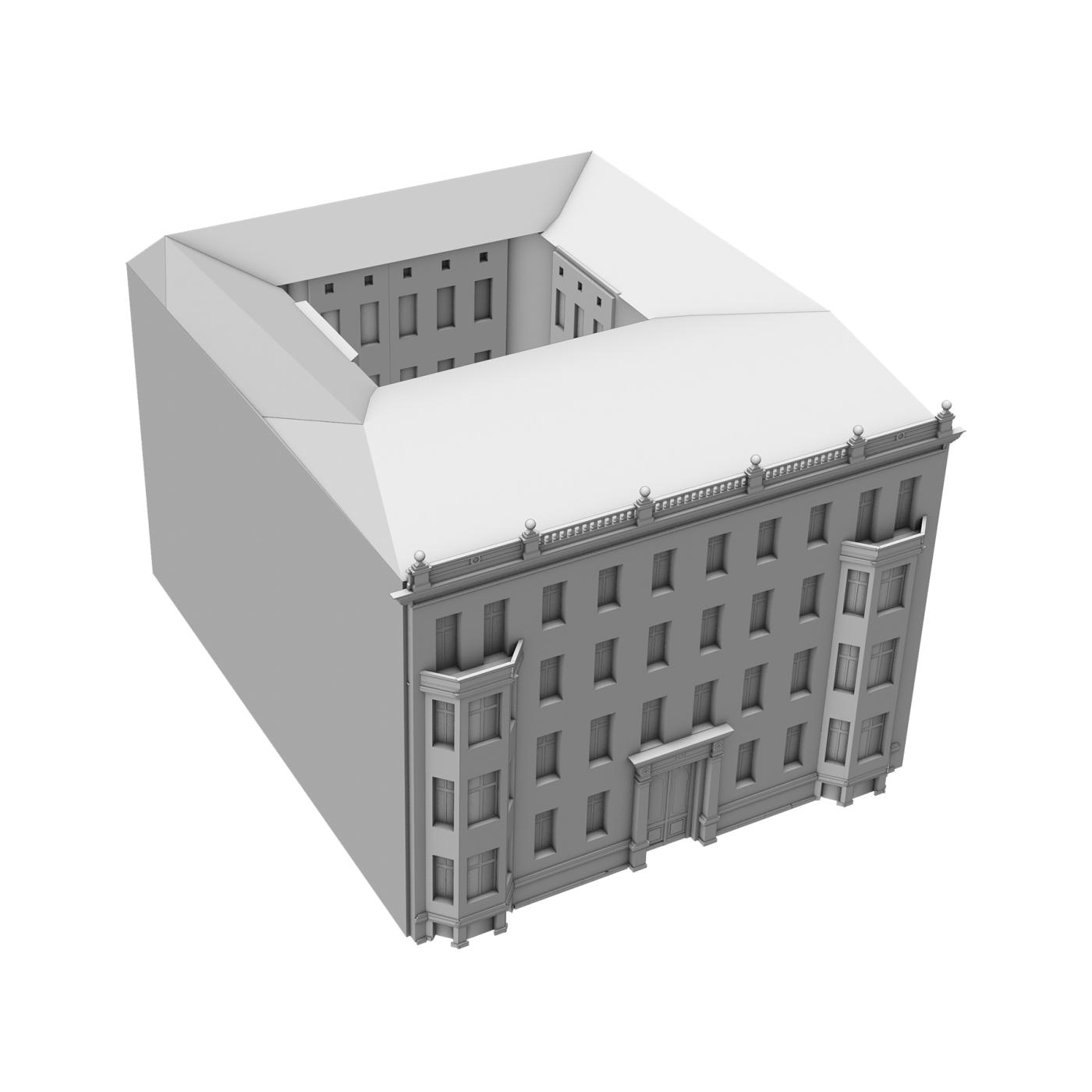
Street-facing building, 1st floor
3.5 rooms
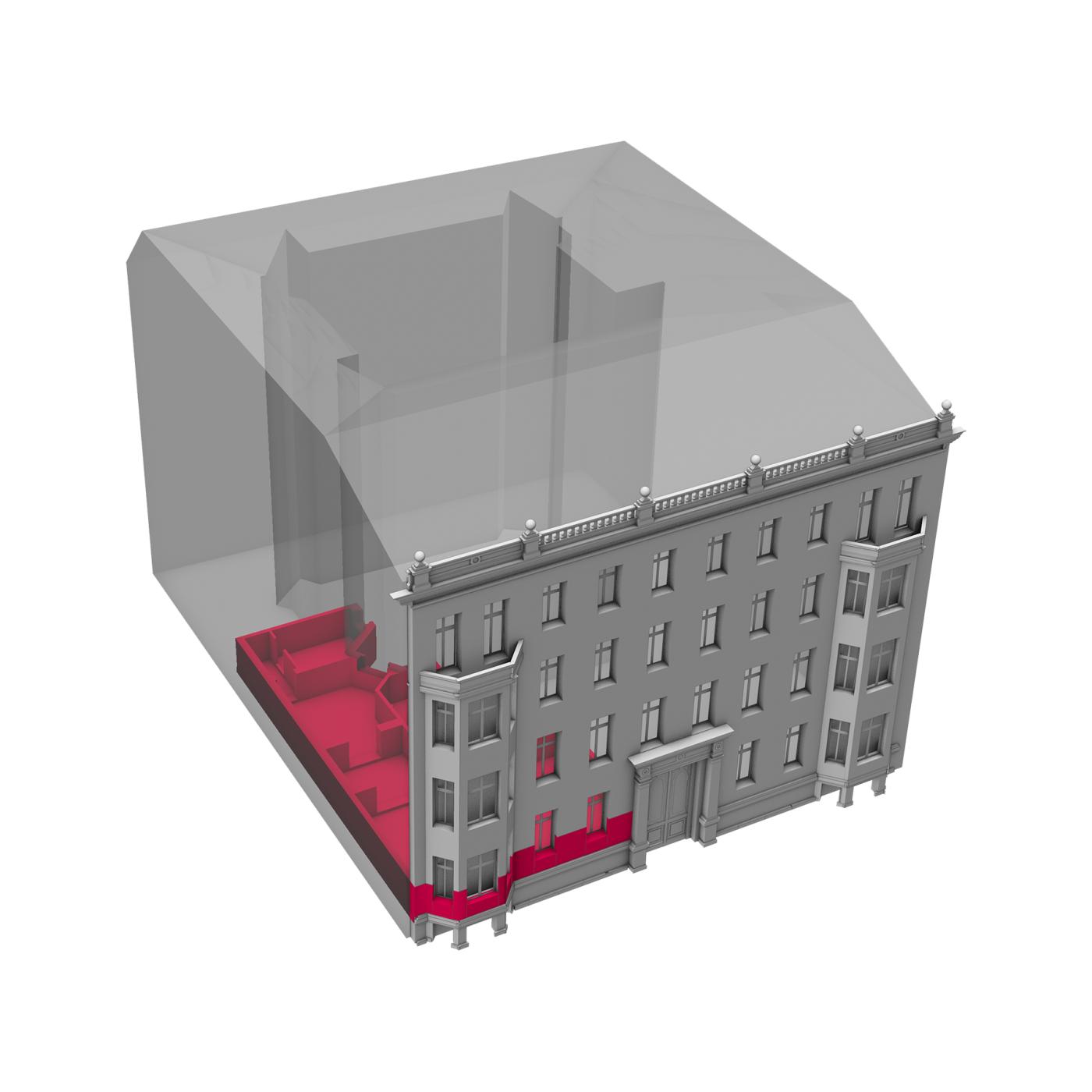
Street-facing building, 1st floor
3.5 rooms
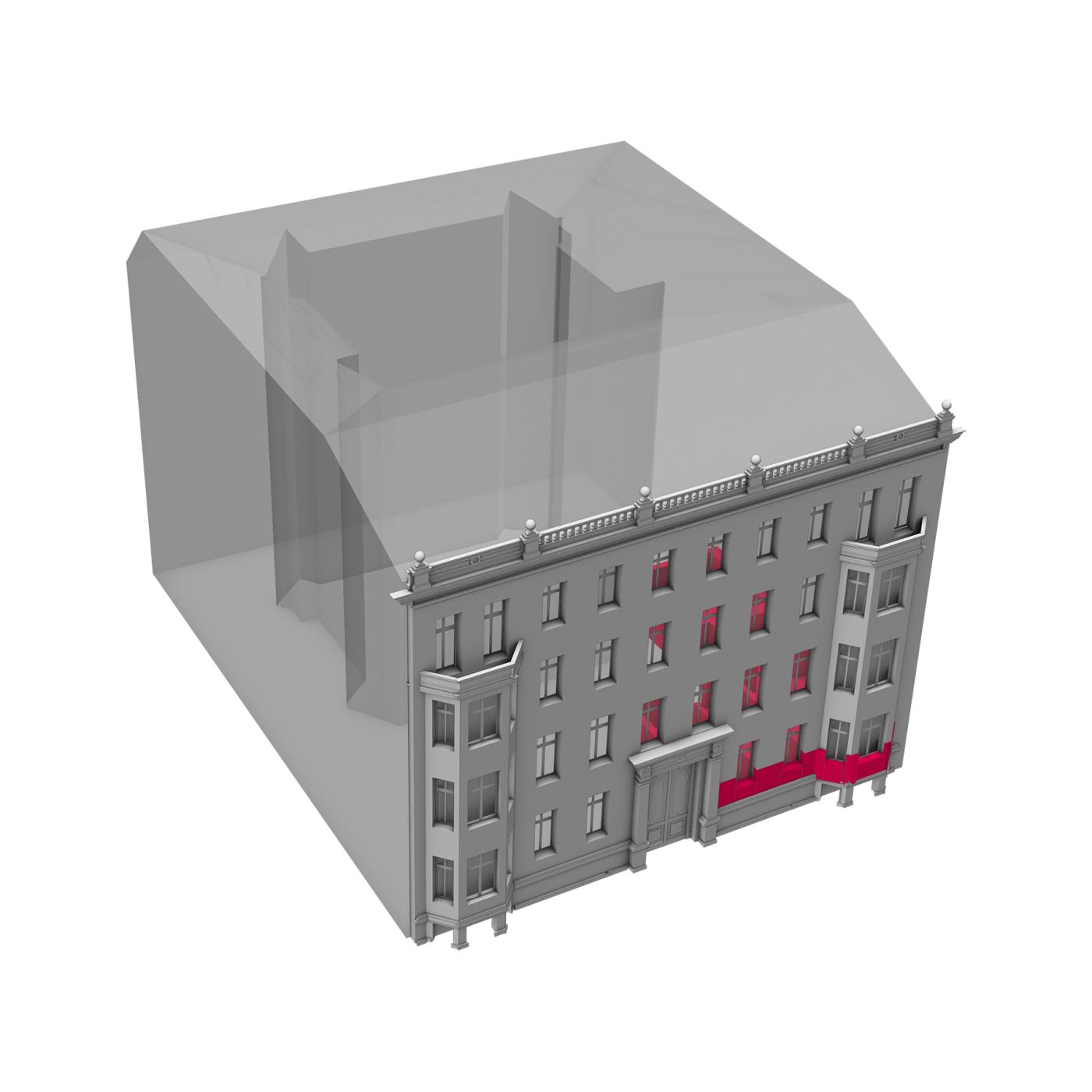
Street-facing building, 2nd floor
1.5 rooms

Street-facing building, 2nd floor
3.5 rooms

Street-facing building, 2nd floor
4.5 rooms
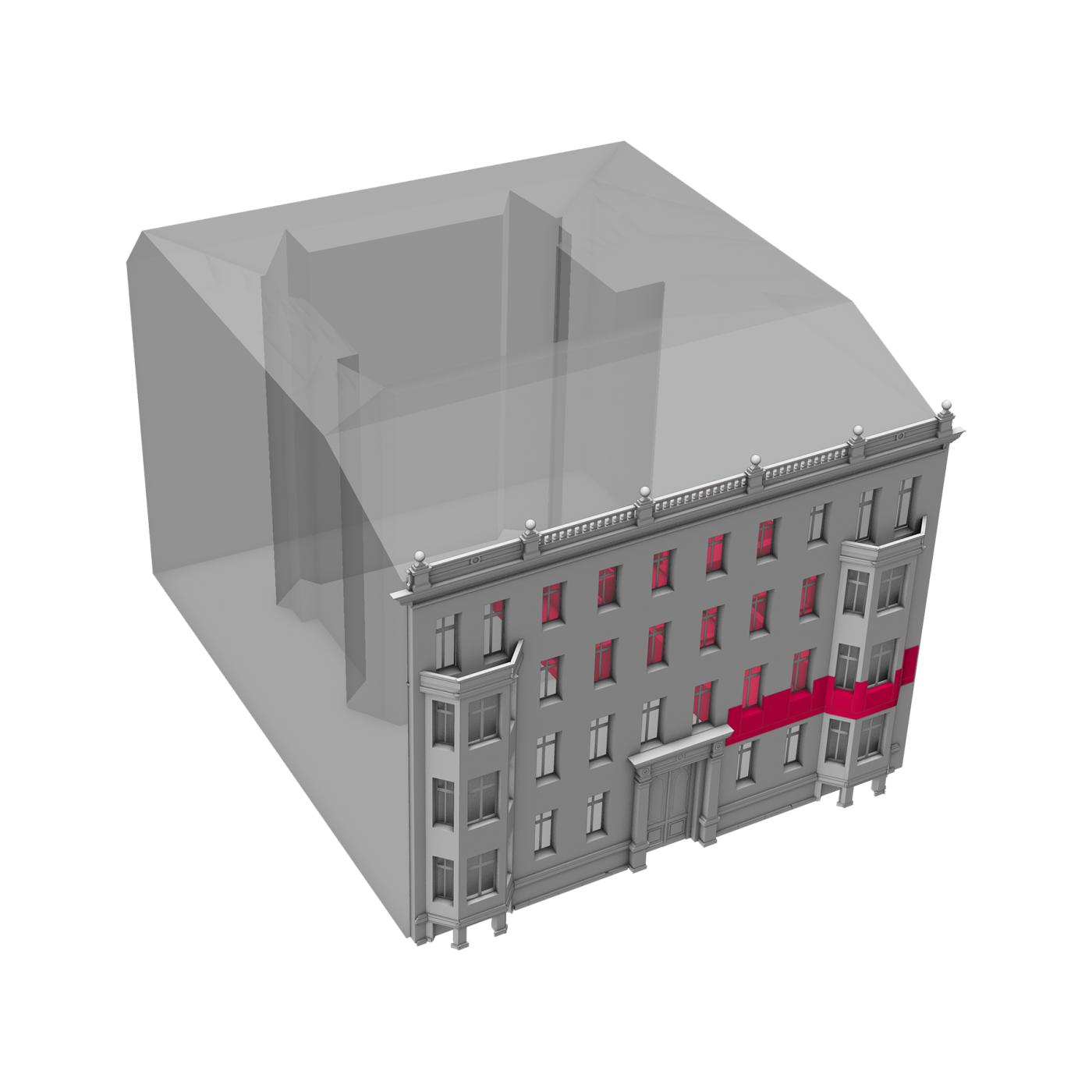
Street-facing building, 3rd floor
4.5 rooms
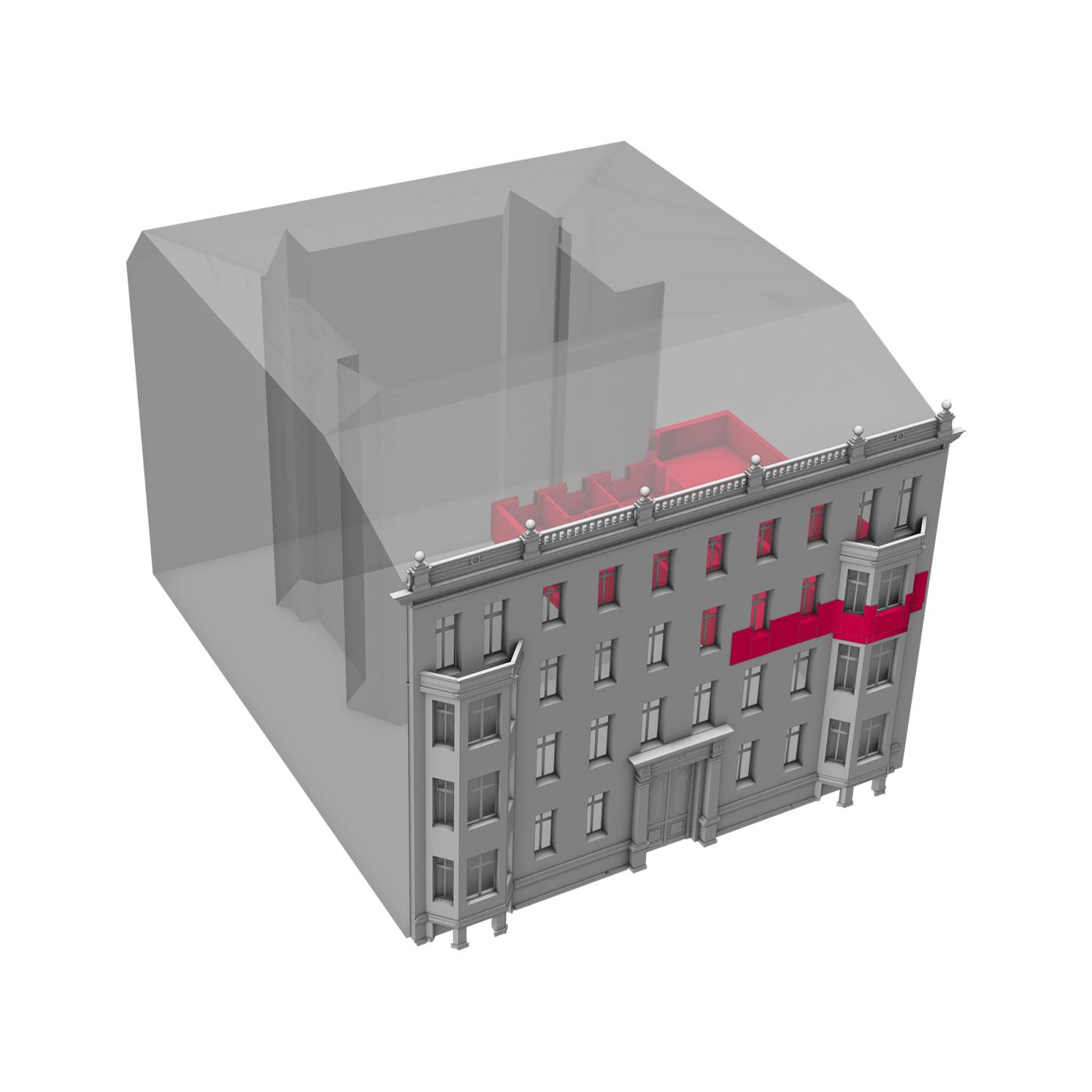
Street-facing building, 3rd floor
3.5 rooms

Side building, basement
1 room
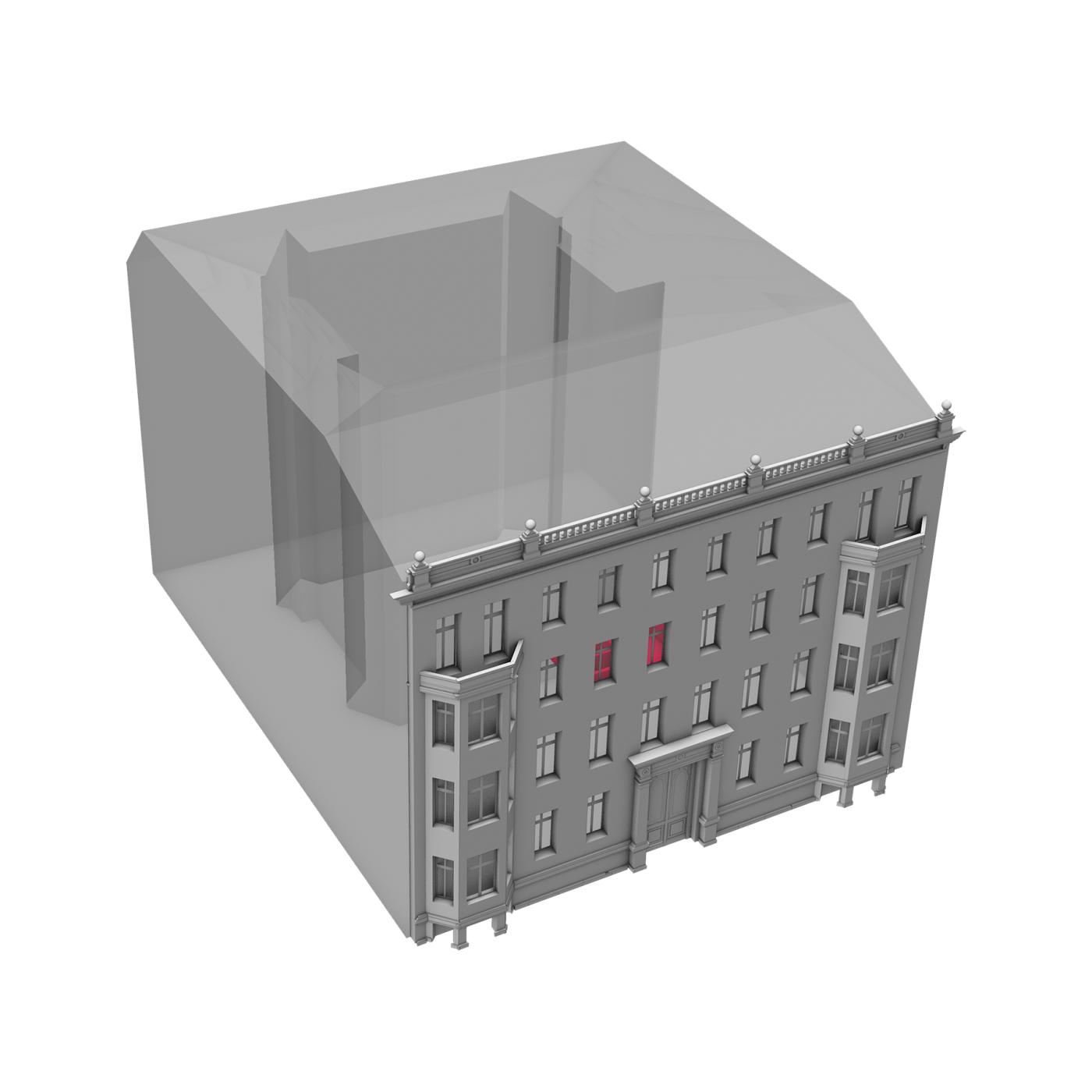
Rear building, 1st floor
2 rooms
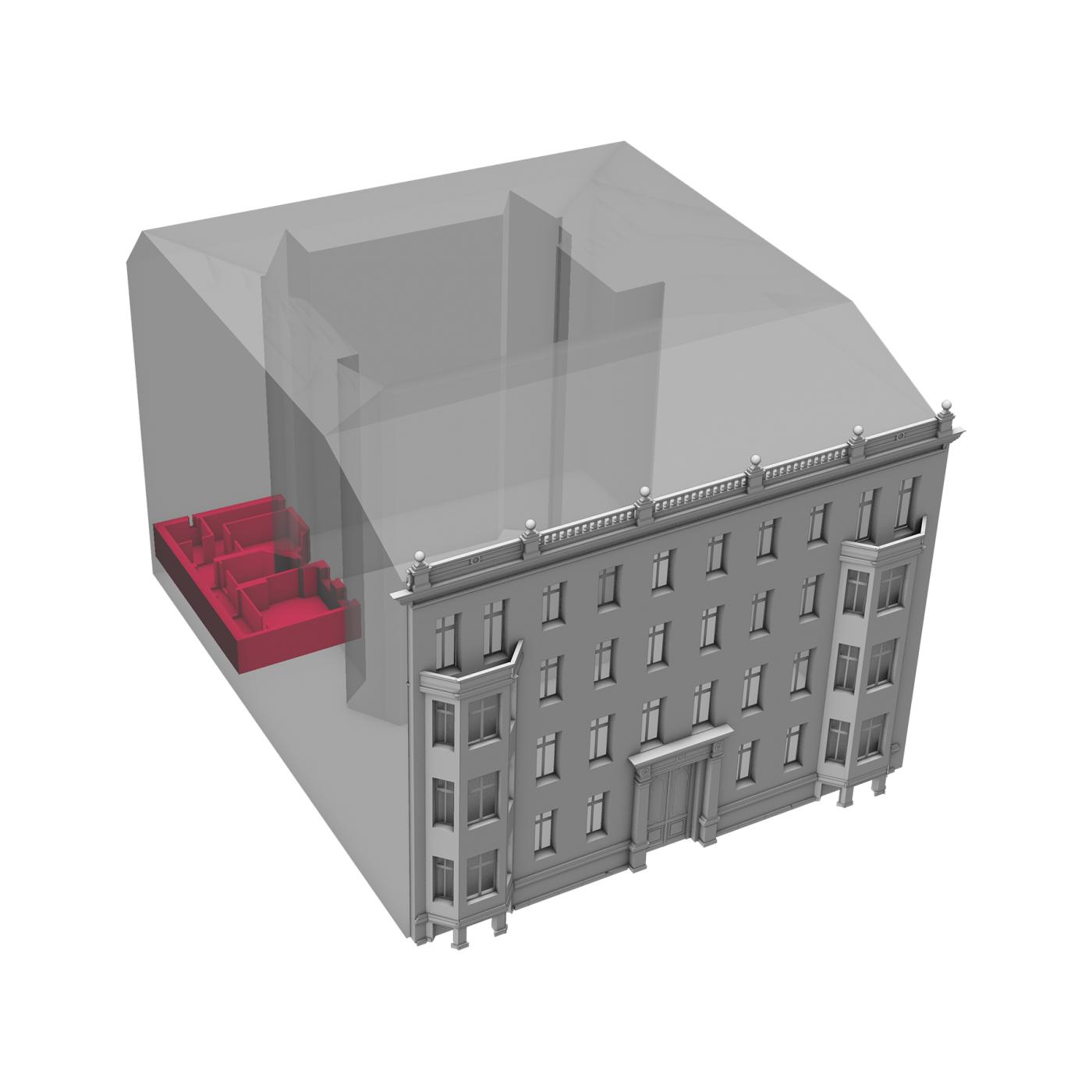
Rear building, 3rd floor
1 room
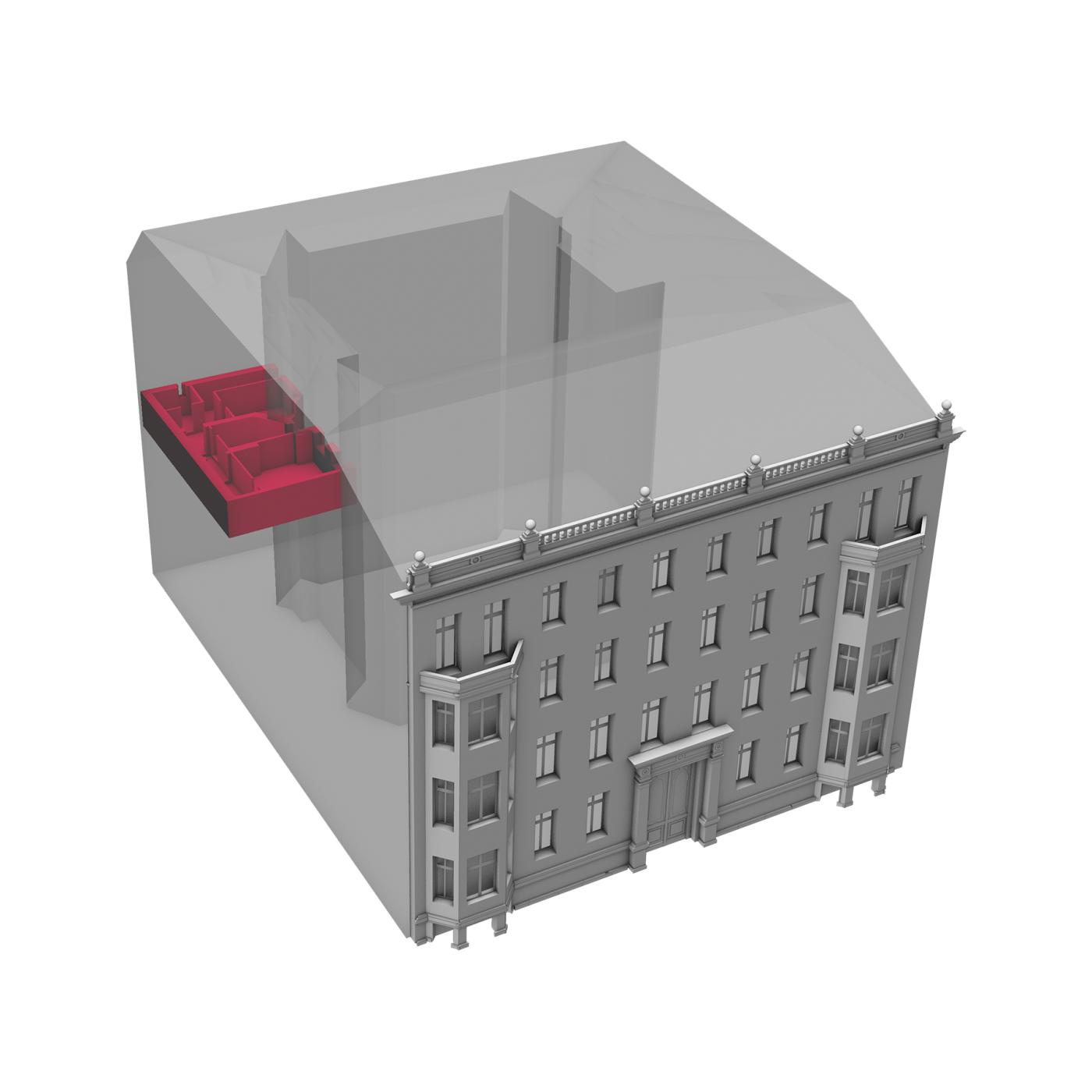
At least 10 forced homes
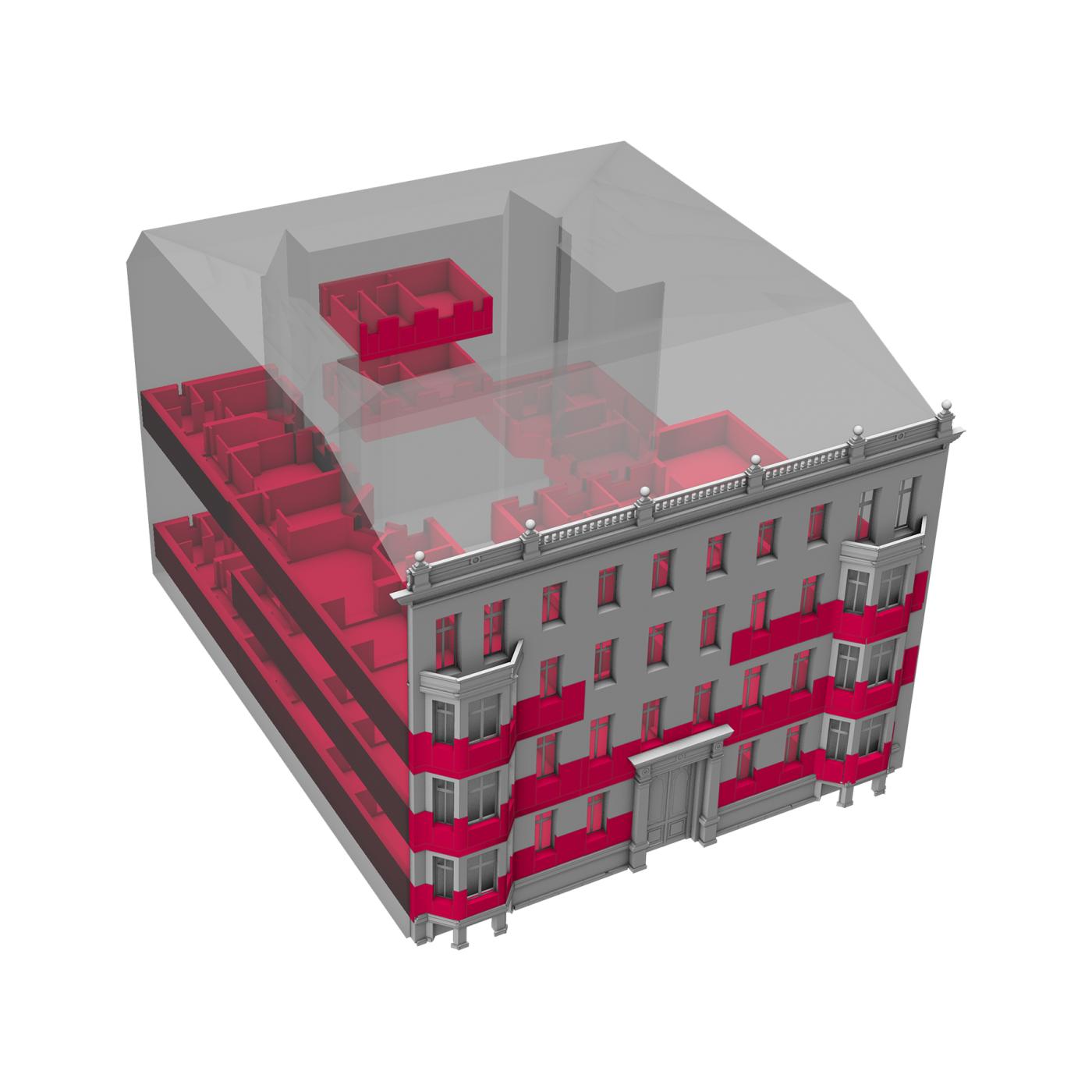
12
Apartments
Street-facing building, 1st floor

Apartment Magnus/Joachimsohn
When the national census was taken on May 17, 1939, Emilie Leichtentritt stated that she was a subtenant of Dr. Julius Magnus. Dr. Magnus was a prominent lawyer at the court of appeal. His office was at Blumeshof 15, but he lived at Meerscheidtstraße 13/15 in Charlottenburg. In August 1939, Julius Magnus fled to the Netherlands to escape Nazi persecution. After Germany’s occupation of the Netherlands, he was deported first to Westerbork transit camp and on September 14, 1943, to Bergen-Belsen concentration camp. In January 1944, he was deported further to Theresienstadt, where he died on May 15, 1944.

His subtenant Emilie Leichtentritt had been resident in the building since November 30, 1937, living initially as a subtenant with Stefan Finkelstein. She moved into Dr. Magnus’ apartment in June 1938. Two months after Dr. Magnus left the country, in October 1939, Jenny Joachimsohn seems to have taken over the lease on the apartment. She had previously lived with her daughter in neighboring Charlottenburg.
Emilie Leichtentritt moved into another apartment on the third floor in September 1941, and Martin and Paula Popper and Paula’s cousin Bella Kussel moved in as subtenants. The Poppers and Bella Kussel were deported a year later, on September 7, 1942, to the Theresienstadt ghetto, where they were all murdered shortly after arriving.
“My father Martin Popper and my mother Paula Popper née Salomon both lived in Berlin-Charlottenburg, at Wundtstr. 64, until the Nazis forced them to leave their apartment and move into an apartment at Blumeshof 15.”
Jenny Joachimsohn and her daughter Käthe had to leave the apartment on April 10, 1943, and move into compulsory accommodation at Heilbronner Straße 22. From there, they were deported two months later to the Theresienstadt ghetto. Jenny Joachimsohn survived. Her daughter Käthe was deported on October 23, 1944, to Auschwitz, where she was murdered.
Street-facing building, raised first floor

Apartment Beer
Alexander and Alice Beer moved into the raised first floor apartment in 1930. They had married in 1924. Alexander Beer was the chief architect for the Berlin Jewish Community and designed schools, homes for the elderly, and synagogues. In April 1939, Alexander and Alice Beer sent their young daughter Beate on a Kindertransport to Southampton in England. She would never see her parents again.



Alice Beer died of cancer on November 5, 1941. Alexander Beer wrote to his daughter Beate to tell her the sad news and express his concerns should he not see her again either.
- 1/4
“My beloved child, I must extend my hopes of seeing you again into the indefinite future […] Should fate not have it so, entrust yourself entirely to your new foster parents. It is my wish that they treat you as their own. Be a good and grateful daughter to them. Keep your parents in fond memory.”
After his wife’s death, Alexander Beer sublet a furnished room to Hedwig Ehrlich. She moved in here in August 1942. However, in the declaration of assets that she completed shortly before she was deported to Auschwitz, she stated that she did not pay any rent. It is likely that Elisabeth Sussmann also lived in the apartment. This is indicated by a handwritten remark next to her name on the deportation list. Hedwig Ehrlich was deported on February 19, 1943, to Auschwitz; Elisabeth Sussmann a short time later, on March 3, 1943. They were both murdered there. Alexander Beer was deported a few weeks later, on March 17, 1943, to the Theresienstadt ghetto, where he died a year later.
Street-facing building, 2nd floor

Apartment Littmann
Edith Littmann, née Eisenstädt, and her husband Hans moved into a 1.5-room apartment without a kitchen at Blumeshof 15 in November 1942. They paid a monthly rent of Reichsmark 80. They had previously lived at Bochumer Straße 19, where they were registered as resident in May 1939. Hans and Edith Littmann were deported on February 19, 1943, to Auschwitz.
About a month later, the apartment was passed to Johann Ostwald, a Propaganda Ministry employee and member of the SS whose previous apartment at Kaiserallee 134 had been damaged in an air raid. Ostwald then negotiated with Edgar Hering, the new, non-Jewish owner of the property, and the Berlin-Brandenburg Chief of Finance (OFP) to have the apartment renovated free of charge.
“The apartment formerly occupied by Littmann (evacuated) in my property Blumeshof 15 was allocated to SS Sturmbannführer Ostwald, a bomb victim, by the municipal planning office. I humbly request that the apartment be renovated at the expense of the city or the Chief of Police in such a way that Herr Ostwald can move into the said apartment.”

Apartment Lamm
In about 1934, Fritz and Helene Lamm, née Meyer, moved into a rented apartment on the second floor of the street-facing building. Fritz Lamm, a lawyer, worked for the Jewish Community of Berlin and was deputy chairman of the Jewish Welfare Office. He and his wife last occupied 3.5 rooms.
Anna Bernstein, née Schuster, a widow, and her brother Ludwig Schuster, who also worked for the Jewish Community of Berlin, moved into another unfurnished room in March 1941. Anna Bernstein was deported on September 23, 1942, to the Theresienstadt ghetto, where she died a year later, allegedly having taken her own life. Her brother Ludwig Schuster was also deported to Theresienstadt, in spring 1943. The Iron Cross he was awarded during the First World War is noted on the deportation list. Ludwig Schuster died in autumn 1944.
Fritz Lamm was arrested on November 9 or 10, 1942, and sent to Sachsenhausen concentration camp. He was murdered a few weeks later, on December 3, 1942. Helene Lamm probably did not know her husband had died when she was deported just a few days later, on December 9, 1942, to Auschwitz, where she was murdered.

Apartment Rosenthal
Max and Cecilie Rosenthal held the lease on this apartment. They had been forced to sell their luxurious house on Rauchstraße following the introduction of the Jewish property tax. Their apartment at Blumeshof 15 had 4.5 rooms, a kitchen and a bathroom. They paid Reichsmark 160 per month.
In September 1941, the Rosenthals sublet a room to Bertha Falkenberg and Johanna Ginsberg. The sisters had been forced to give up their apartment at Trendelenburgstraße 16, sell almost all their furniture and take this room for Reichsmark 60 per month. They were deported on August 26, 1942, to the Theresienstadt ghetto. Bertha Falkenberg survived: She was among the prisoners released to Switzerland in February 1945. Johanna Ginsberg died on March 7, 1943, in the ghetto.
Cecilie Rosenthal was deported on May 17, 1943, and murdered in Auschwitz. Her husband Max Rosenthal was being treated in the Jewish hospital at the time. When he had recovered, he was deported to the Theresienstadt ghetto. Despite his advanced age, he survived.
The Rosenthals’ apartment was to be assigned to Lieutenant Otto Schnee, a naval officer. This was decided almost two months before Cecilie Rosenthal was deported, suggesting that the decision of when to send residents to their death was connected to how urgently their apartment was required.
“I urgently request priority clearance. The applicant [Otto Schnee] wishes to take over the residence.”
Street-facing building, 3rd floor

Apartment Henschke/Marx
Martha Henschke, née Meyer, and Else Marx, née Löwenthal, shared an apartment on the third floor from March 1939 on. Both widows, they equally shared the rent of Reichsmark 160. Else Marx occupied one room, which she shared with her sister Betty Löwenthal from April 1939 on. Martha Henschke was a leading member of the Berlin Jewish Community and head of a department for homes for the elderly and people with special needs. Martha Henschke wrote in her declaration of assets shortly before her deportation that she occupied two rooms and the hallway.
In late August 1941, Emilie Leichtentritt moved in as a subtenant. She had previously lived in Dr. Julius Magnus’ apartment on the second floor. Another furnished room in the apartment was sublet to Lilli Rosenberg in April 1942. She stated that she lived as a subtenant with Else Marx. Herbert Rosenthal, however, who moved in at an unknown point in time and only occupied a “sleeping place”, stated that Martha Henschke was the main tenant. Emilie Leichtentritt was the first of the apartment’s occupants to be deported. She was sent on January 19, 1942, to the Riga ghetto. Else Marx and her sister Betty Löwenthal were deported on October 3, 1942, to the Theresienstadt ghetto. Two weeks later, on October 19, 1942, Herbert Rosenthal was deported to the Riga ghetto and from there, a year later, to Auschwitz. Martha Henschke was probably deported with ten other Berlin Jewish Community employees on December 9, 1942, to Auschwitz, where she was murdered on June 3, 1943. Lilli Rosenberg was deported on February 19, 1943. None of the occupants survived.

Apartment Bendit
Paula Bendit moved into a 3-room apartment on the third floor with her mother Anna Schwersenz, née Michaelis, in November 1938. In 1940, they sublet a room to Lotte Brinn for Reichsmark 60. In October 1941, her mother Jenny Brinn, née Scheps, also moved in and they shared the room. They sublet another furnished room to Ernst Nathan Levy in June 1941. All the occupants were deported between September and November 1942 to the Riga ghetto, Theresienstadt ghetto, or Auschwitz. Only Anna Schwersenz survived.

In March 1943, Paula Bendit’s apartment was allocated to Hermann Behrens, a senior municipal building adviser, whose home had been damaged in an air raid. Behrens wrote to the Chief of Finance (OFP) requesting that the apartment be cleaned and renovated. Many non-Jewish tenants requested that the former forced homes be disinfected and refurbished after their previous occupants had been sent away to be murdered.
“It is a Jew home, enforcement officers from your administration […] opened the last rooms only yesterday. The furniture it contained […] has been collected by a dealer. The apartment was then thoroughly cleaned at my behest and expense […] by a cleaning woman.”
Rear building, basement

Apartment Urbach
Hertha Urbach lived with her small children Ruth and Lothar in one room in the basement apartment in the rear building from 1938 on. She paid a monthly rent of Reichsmark 20.32. In May 1941, a subtenant named Martin Israel moved in, who paid Reichsmark 20 for a “sleeping place”. Both adults worked as forced laborers: Hertha Urbach in the Siemens-Schuckert factory; Martin Israel in the Fritz Müller paper factory. All the members of the household were deported on February 19, 1943, to Auschwitz and murdered.
Rear building, 1st floor

Apartment Lipkowitz
Alfred and Gertrud Lipkowitz were the main tenants of this apartment in the rear building. They lived in two rooms with their children Ralf and Bela, and paid Reichsmark 50 rent. In 1940 Regina Moskiewicz moved in as a subtenant of the family, paying half the rent. The Lipkowitz family and Regina Moskiewicz were deported on February 19, 1943, to Auschwitz and murdered. About a month later, the apartment was assigned to Hans Nebel, a metal worker.
Rear building, 2nd floor

Apartment Zwillenberg
Wilhelm Zwillenberg, a musician, lived here with his wife Pauline Zwillenberg, née Goldstücker. They both managed to escape in October 1939 via Italy to Palestine. For this reason, the apartment cannot be considered a forced home.
Rear building, 3rd floor

Apartment Lazarus
The only person known to have occupied this small 1-room apartment with a kitchen, hallway, bathroom and attic was Flora Lazarus, who moved in here in July 1934. In the declaration of assets that she completed shortly before her deportation, she stated that she paid a monthly rent of Reichsmark 47.50. Flora Lazarus was deported on September 7, 1942, to the Theresienstadt ghetto and survived. In January 1943, her apartment was rented out again; to whom is not known.

Apartment Grodka
The main tenants of this 1-room apartment were Franziska Grodka and her husband Arthur Grodka. They moved here from Kurfürstenstraße 124 sometime after the national census of May 1939. They paid Reichsmark 47.50 rent per month. The Grodkas were deported on March 12, 1943, to Auschwitz and murdered.
Apartment Frank
Who the main tenants of this apartment were is not known. Husband-and-wife Siegfried and Dorothea Frank moved into one room as subtenants in 1939. They paid a monthly rent of Reichsmark 30. The Franks were deported on November 29, 1942, to Auschwitz, where they were murdered.
Rear building, 4th floor

Apartment Latte
Little is known about Johanna (Hannchen) Latte, née Gellhaar. She was born in Arnswalde and moved into a room at Blumeshof 15 before May 1939. A “Frau F. Latte” is listed as resident at this address in the Berlin directory of 1935. It is likely the “J” of Johanna had been mistakenly read as an “F”: the two letters can be hard to differentiate in Gothic type.

Johanna Latte apparently lived alone. There are no indications that her modest apartment, for which she paid Reichsmark 50 per month, was used as compulsory accommodation. Johanna Latte was deported on September 7, 1942, aged 72, to the Theresienstadt ghetto, where she died some weeks later, on November 26, 1942.
Unknown location
Apartment Rosenbaum
Gestapo records show that Blumeshof 15 was the last known Berlin address of Ellen Rosenbaum, née Jacoby. Her husband Heinz Rosenbaum evidently stayed in the apartment at Neue Winterfeldtstraße 28 that the couple had previously shared. Little information on the Rosenbaums has survived. They evidently managed to escape before they were enlisted for deportation. Ellen Rosenbaum emigrated on November 18, 1936, to South Africa and was robbed of everything she owned by the German state. Heinz Rosenbaum fled on September 1, 1936, to an unknown destination, possibly New York. Both had their German citizenship withdrawn after emigrating. What happened to them later is not known.
Apartment Jacoby
Alexander Jacoby was one of the Jewish people who managed to escape from Germany before the mass deportations to extermination camps began. Where exactly and for how long he lived at Blumeshof 15 is not known. In the Berlin directory of 1935, he is listed as working in the real estate sector. He owned a property at Oranienstraße 21 in Kreuzberg. During or shortly after the November pogrom of 1938, he was arrested and jailed in Sachsenhausen concentration camp, where he was given the prisoner number 9115. He was released on December 13, 1938. Two weeks later, his business was deleted from the commercial register. He fled to the United Kingdom on July 18, 1939, and his property and all his assets, including the building at Oranienstraße 21, fell to the German state. On October 7, 1939, he was released from internment in Bradford, England. It is noted on his release paper that he was an estate broker. He was granted US citizenship in New York in November 1952.

Apartment Witkowski
Alfred Witkowski, a physician, had lived at Blumeshof 15 for many years before he was arrested in November 1938 and imprisoned in Sachsenhausen concentration camp. His wife Hedwig Witkowski, née Mosse, was a member of the Berlin Jewish Community Council – like Bertha Falkenberg, her neighbor on the second floor. Hedwig Witkowski was a cousin of Martha Mosse, head of the housing advice office. Alfred and Hedwig Witkowski fled on May 15, 1939, to Australia. The Witkowskis’ property, including a number of buildings owned by Hedwig Witkowski, was confiscated by the state in 1942.




Neighborhood
The area around Blumeshof 15 was a sedate, middle-class neighborhood of villas and grand residential buildings in leafy surroundings, close to Berlin’s central Tiergarten park. Many well-known public figures lived in the street, including members of the Jewish Community of Berlin. But there was also a significant site of anti-Jewish persecution on the street: The Reich Culture Chamber, responsible for ostracizing and ousting numerous Jewish artists, was located at Blumeshof 2-6.
Author
Bethan Griffiths
Alexander Beer
Born September 10, 1873, in Hammerstein
Deported March 17, 1943, to the Theresienstadt ghetto, died May 8, 1944
Alice Beer, née Davidsohn
Born August 19, 1893, in Berlin
Died November 5, 1941
Paula Bendit, née Schwersenz
Born November 18, 1888, in Berlin
Deported September 7, 1942, to the Theresienstadt ghetto; October 12, 1944, to Auschwitz, murdered
Anna Bernstein, née Schuster
Born September 15, 1876, in Köln
Deported September 23, 1942, to the Theresienstadt ghetto, died November 15, 1943
Else Brand, née Wolff
Born September 22, 1912, in Völklingen
Survived
Ursula Brand
Born May 24, 1935, in Berlin
Survived
Jenny Brinn, née Scheps
Born February 6, 1883, in Militsch (Milicz)
Deported 29, 1942, to Auschwitz, murdered
Lotte Brinn
Born January 20, 1906, in Berlin
Deported November 29, 1942, to Auschwitz, murdered
Hanna Caro
Born July 10, 1899, in Berlin
Suicide November 13, 1941
Carl Croner
Born May 7, 1880, in Berlin
Survived
Frieda Czarlinski
Born January 10, 1862 (or January 9, 1862), in Bordzichow (Borzechowo)
Deported March 3, 1943, to Auschwitz, murdered
Henriette Czarlinski
Born July 20, 1866, in Śliwice
Deported March 3, 1943, to Auschwitz, murdered
Frieda Dallmann
Born February 5, 1896, in Wriezen
Deported March 12, 1943, to Auschwitz, murdered
Hedwig Ehrlich, née Altmann
Born December 12, 1881, in Bautzen
Deported February 19, 1943, to Auschwitz, murdered
Bertha Falkenberg, née Ginsberg
Born April 8, 1876, in Berlin
Deported August 26, 1942, to the Theresienstadt ghetto, released and migrated to Switzerland February 5, 1945
Survived
Dorothea Frank, née Kallmann
Born March 11, 1899, in Wronki
Deported November 29, 1942, to Auschwitz, murdered
Siegfried Frank
Born June 4, 1891, in Frankfurt am Main
Deported November 29, 1942, to Auschwitz, murdered
Johanna Ginsberg
Born May 14, 1879, in Berlin
Deported August 26, 1942, to the Theresienstadt ghetto, died March 7, 1943
Arthur Grodka
Born January 9, 1883, in Wohlau
Deported March 12, 1943, to Auschwitz, murdered
Franziska Grodka, née Berger
Born September 14, 1879, in Zempelburg (Sępólno)
Deported March 12, 1943, to Auschwitz, murdered
Johanna Guttmann, née Meschelsohn
Born June 30, 1868, in Berlin
Deported August 26, 1942, to the Theresienstadt ghetto, died January 10, 1943
Martha Henschke, née Meyer
Born June 19, 1879, in Berlin
Deported December 9, 1942, to Auschwitz, murdered June 3, 1943
Mirjam Hirsch, née Gläsner
Born December 10, 1887, in Krakau (Kraków)
Deported January 13, 1942, to the Riga ghetto, died
Martin Israel
Born July 17, 1911, in Wittenberg
Deported February 19, 1943, to Auschwitz, murdered
Alexander Jacoby
Born March 1, 1880, in Berlin
Escaped July 18, 1939, to the United Kingdom
Survived
Jenny Joachimsohn, née König
Born August 21, 1874, in Berlin
Deported June 16, 1943, to the Theresienstadt ghetto
Survived
Käthe Joachimsohn
Born December 18, 1896, in Berlin
Deported June 16, 1943, to the Theresienstadt ghetto; October 23, 1944, to Auschwitz, murdered
Max Kallmann
Born March 28, 1896, in Wronki
Deported March 3, 1943, to Auschwitz, murdered
Else Krayn, née Chrzellitzer
Born November 26, 1888, in Berlin
Deported March 3, 1943, to Auschwitz, murdered
Bella Kussel, geb. Lichtenstein
Born December 17, 1865, in Magdeburg
Deported September 7, 1942, to the Theresienstadt ghetto, died September 27, 1942
Fritz Lamm
Born December 21, 1876, in Görlitz
Imprisoned November 9, or 10, 1942, in Sachsenhausen concentration camp, murdered December 3, 1942
Helene Lamm, née Meyer
Born December 14, 1870, in Mannheim
Deported December 9, 1942, to Auschwitz, murdered
Sonja Lange
Born September 28, 1926, in Berlin
Deported to an unknown destination
Survived
Johanna (Hannchen) Latte, née Gellhaar
Born October 23, 1869, in Arnswalde
Deported September 7, 1942, to the Theresienstadt ghetto, died November 26, 1942
Flora Lazarus
Born January 22, 1868, in Rogoźno (Rogasen)
Deported September 7, 1942, to the Theresienstadt ghetto
Survived
Emilie Leichtentritt
Born March 20, 1893, in Berlin
Deported January 19, 1942, to the Riga ghetto, murdered
Ernst Nathan Levy
Born May 29, 1885, in Hamburg
Deported October 3, 1942, to the Theresienstadt ghetto, died
Günther Lilienheim
Born October 29, 1926, in Berlin
Survived
Leisor Lilienheim
Born November 6, 1901, Warsaw (Warszawa)
Deported to Auschwitz, murdered March 10, 1943
Alfred Lipkowitz
Born December 7, 1894, in Berlin
Deported February 19, 1943, to Auschwitz, murdered
Bela Lipkowitz
Born March 28, 1941, in Berlin
Deported February 19, 1943, to Auschwitz, murdered
Gertrud Lipkowitz, née Perlinsky
Born February 14, 1904, in Berlin
Deported February 19, 1943, to Auschwitz, murdered
Ralf Robert Lipkowitz
Born April 18, 1930, in Berlin
Deported February 19, 1943, to Auschwitz, murdered
Edith Littmann, née Eisenstädt
Born June 7, 1895, in Berlin
Deported February 19, 1943, to Auschwitz, murdered
Hans Littmann
Born October 12, 1897, in Berlin
Deported February 19, 1943, to Auschwitz, murdered
Betty Löwenthal
Born September 5, 1874, in Anklam
Deported October 3, 1942, to the Theresienstadt ghetto, died December 29, 1942
Robert London
Born January 20, 1877, in Kropien
Deported February 19, 1943, to Auschwitz, murdered
Rosalie London, née Rosenthal
Born March 25, 1880, in Nikolaiken (Mikołajki)
Deported February 19, 1943, to Auschwitz, murdered
Julius Magnus
Born September 6, 1867, in Berlin
Fled August 25, 1939, to the Netherlands, imprisoned in Westerbork transit camp, deported September 14, 1943, to Bergen-Belsen concentration camp; January 25, 1944, to the Theresienstadt ghetto, died May 15, 1944
Arthur Mannheim
Born June 16, 1881, in Dyherfurth
Died July 2, 1943
Else Marx, née Löwenthal
Born June 24, 1877, in Anklam
Deported October 3, 1942, to the Theresienstadt ghetto; December 18, 1943, to Auschwitz, murdered December 30, 1943
Regina Moskiewicz, née Stenger
Born September 17, 1888, in Berlin
Deported February 19, 1943, to Auschwitz, murdered
Sara Pessen, née Kallmann
Born May 21, 1890, in Wronki
Deported December 14, 1942, to Auschwitz, murdered
Martin Popper
Born April 26, 1861, in Stolp
Deported September 7, 1942, to the Theresienstadt ghetto, died September 25, 1942
Paula Popper, née Salomon
Born December 16, 1874, in Hannover
Deported September 7, 1942, to the Theresienstadt ghetto, died September 19, 1942
Erna Rachum
Born February 12, 1893, in Berlin
Deported January 29, 1943, to Auschwitz, murdered
Sara Rachum, née Krawietz
Born August 27, 1866, in Schrimm (Śrem)
Died February 4, 1940
Ellen Rosenbaum, née Jacoby
Born February 28, 1912, in Berlin
Escaped November 18, 1936, to South Africa
Survived
Lilli Rosenberg
Born January 14, 1892, in Berlin
Deported February 19, 1943, to Auschwitz, murdered
Cecilie Rosenthal, née Sina
Born April 30, 1884, in Guttau
Deported May 17, 1943, to Auschwitz, murdered
Herbert Rosenthal
Born April 29, 1925, in Berlin
Deported October 19, 1942, to the Riga ghetto; November 5, 1943, to Auschwitz, murdered
Max Rosenthal
Born October 15, 1875, in Berlin
Deported June 16, 1943, to the Theresienstadt ghetto
Survived
Ludwig Schuster
Born October 19, 1877, in Cologne
Deported March 17, 1943, to the Theresienstadt ghetto, died October 20, 1944
Paul Schuster
Born September 1, 1867, in Cologne
Fled July 1939 to the United Kingdom, died April 6, 1940
Sophie Schuster, née Horwitz
Born November 28, 1880, in Berlin
Fled before November 1939 to the United Kingdom
Survived
Anna Schwersenz, née Michaelis
Born August 31, 1863, in Berlin
Deported September 7, 1942, to the Theresienstadt ghetto
Survived
Elisabeth Sussmann, née Zander
Born August 14, 1879, in Konitz
Deported March 3, 1943, to Auschwitz, murdered
Hertha Urbach, née Moszler
Born May 24, 1910, in Stolp
Deported February 19, 1943, to Auschwitz, murdered
Lothar Urbach
Born August 27, 1934, in Berlin
Deported February 19, 1943, to Auschwitz, murdered
Ruth Urbach
Born March 13, 1932, in Berlin
Deported February 19, 1943, to Auschwitz, murdered
Gertrud Weill, née Grünpeter
Born January 29, 1882, in Breslau (Wrocław)
Deported June 13, 1942, to Sobibor extermination camp, murdered
Inge Weinstock
Born May 13, 1928, in Berlin
Deported October 26, 1942, to the Riga ghetto, murdered October 29, 1942
James Weinstock
Born October 26, 1900, in Berlin
Deported October 26, 1942, to the Riga ghetto, murdered October 29, 1942
Selma Weinstock, née Lewin
Born November 15, 1902, in Berlin
Deported October 26, 1942, to the Riga ghetto, murdered October 29, 1942
Martha Wertheim, née Gutmann
Born April 16, 1891, in Berlin
Deported August 26, 1942, to the Theresienstadt ghetto, died January 20, 1943
Alfred Witkowski
Born January 16, 1875, in Gnesen (Gniezno)
Fled May 15, 1939, to Australia, died December 20, 1940
Hedwig Witkowski, née Mosse
Born May 18, 1884, in Frankfurt/Main
Fled May 15, 1939, to Australia
Survived
Pauline Zwillenberg, née Goldstücker
Born June 7, 1874, in Rogasen (Rogoźno)
Fled October 1939 to Palestine
Survived
Wilhelm Zwillenberg
Born April 20, 1871, in Ortelsburg (Szczytno)
Fled October 1939 to Palestine
Survived










